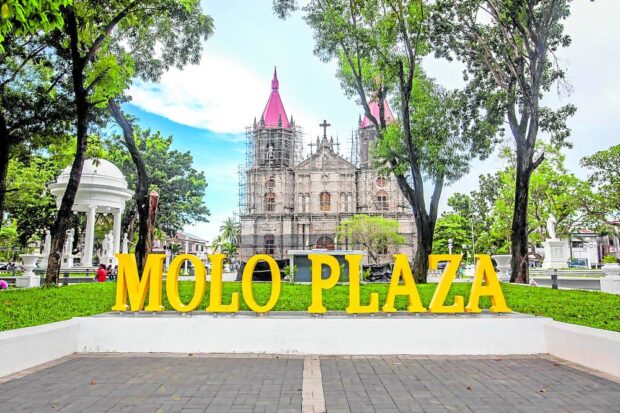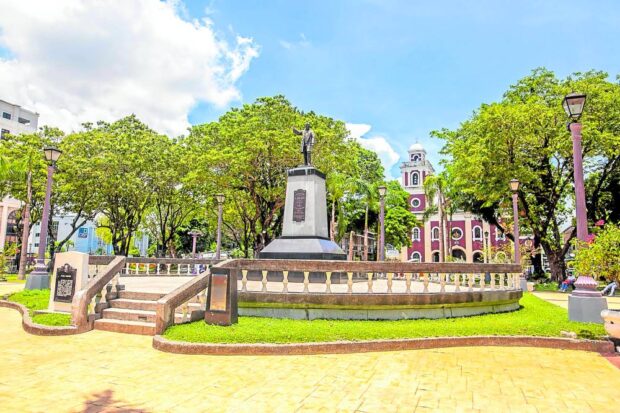Reinvigorating Iloilo City’s plazas

Molo Plaza is just one of the city’s six district plazas that are being rehabilitated to give residents and visitors a place to relax and recharge. —PHOTO BY IAN PAUL CORDERO
ILOILO CITY—Children are playing in a corner. Near the monkey bar, young men are doing calisthenics. Couples are sitting inside the gazebo while a group of friends is strolling nearby.
This has been the usual scene at the Molo Plaza since it reopened last year after a yearlong rehabilitation.
Molo Plaza, built in the 1920s as the center of the then-municipality of Molo, is in front of the St. Anne parish church, which, according to historical records, was visited by Dr. Jose Rizal when he was in Iloilo in 1886. The church was designated as a national historical landmark in 1992 by the National Historical Institute (NHI), predecessor of the National Historical Commission of the Philippines (NHCP).
Aside from the P20 million funds from the NHCP, power distributor MORE Power and Electric Corp. paid for the restoration of the lighting in the plaza and church.
Statues of Greek goddesses and Maria Clara that adorn the plaza have also been restored while the concrete pebbled pathways have been replaced with bricks. The well-lit fountain as well as the classical music being played through a sound system complete the look of the plaza that has been dubbed as “Athens of the Philippines.”
Molo Plaza is just one of the city’s six district plazas that have been getting a full rehabilitation by the city government to provide open spaces for residents and visitors where they can relax and recharge. These projects include removal of taller fences and barricades as well as opening these to the public 24 hours a day, seven days a week.The restoration of Plaza Libertad, fronting the Iloilo City Hall, worth P19.7 million, has started.
Plaza Libertad is important to the Ilonggos because it is where the Spaniards surrendered to Filipino revolutionaries, led by General Martin Delgado, on Christmas Day in 1898.
The plaza used to be square-shaped but it has been extended to the entrance of the City Hall along I. De La Rama Street, including an Assembly Area where the flag-raising ceremony is being held every Monday morning.
The lighting has been fixed while the fountain and statues have been restored. Aside from steel benches, bike parking ramps have also been installed.
Like the Molo Plaza, classical songs are played from a sound system.
Historic bells
In November last year, the bells at the newly restored Jaro Belfry pealed for the first time in 74 years since its second and third floors were damaged by a strong earthquake in 1948.
The ringing of the bells marked the 29-meter-tall bell tower’s reopening following its restoration. It has since been turned over to the Archdiocese of Jaro.
The city government and the NHCP also led the soft reopening of the Jaro Plaza, now called Graciano Lopez Jaena Park, named after Jaro’s favorite son.
Aside from a monument to Ilonggo veterans from World War II, a bandstand and a statue of Lopez Jaena, a shrine honoring local hero, Patrocinio Gamboa, has been erected in the plaza.
Gamboa led the hoisting of the Philippine flag—the first outside of Luzon—in Delgado’s headquarters in Santa Barbara town in time for the inauguration of the Philippine revolutionary government.
The design of the three plazas was conceptualized by PGAA Creatives headed by renowned landscape architect Paulo Alcazaren, who is credited as the brains behind the city’s now-famous Iloilo River Esplanade, a 9-kilometer-long linear park along Iloilo River.
Urban greene
ryAside from these three plazas, the smaller Mandurriao Plaza has been reopened this year, with expanded pathways and more greenery, benches and lamps.
The Mandurriao rehabilitation, worth P17 million, is funded under the “Green, Green, Green” program of the Department of Budget and Management and is being implemented by the City Engineer’s Office.
The City Environment and Natural Resources Office (Cenro) also installed additional “green guards” who used to be seen only at the Iloilo Esplanade, to man the maintenance and security of the plazas.
Cenro head Neil Ravena, whose office oversees the management and operation of the city’s plazas, said that the city government’s vision was to transform plazas into urban landscapes.
He said that two phases were involved in the rehabilitation work. One is called “hard,” involving improvement of pavements and drainage systems while “soft” involves the planting of trees and flowering plants, among others, and other smaller but equally significant components.
“The goal is to open up (and remove) their fences, to serve as open spaces. All structures in the plazas will be demolished, and [will be made into] landscapes, calling it urban landscaping. We also introduced biodiversity with the planting of native trees and historical value as incorporated in their design,” said Ravena.
The city’s vision, he said, is for the plazas to stimulate the senses.
The plazas, he added, must also complement the surrounding public structures, citing Plaza Libertad whose design is beautifully meshed with the City Hall facing it.
The city is also looking into building additional public toilets but it wanted to ensure that these facilities’ design would not interfere with the vibe of the plazas.
Gov’t supportThe national government has extended financial support for the redevelopment of the plazas because most are either located in the city’s Central Business District, or near Fort San Pedro facing the Iloilo Strait, which have been designated as Cultural Heritage Tourism Zones under Republic Act No. 10555.
Still, both La Paz Plaza and Arevalo Plaza are being redeveloped through the city government, which has allocated P90 million and P40 million for these projects.
Arevalo Plaza, the only plaza without fences since its conception, has reopened, with refreshed greenery, replaced brick tiling, and new solar-powered lighting.
Rehabilitation cost for the La Paz Plaza is higher because it involves the construction of an amphitheater and a promenade that includes a fountain.
The promenade will stretch by about 10 meters all the way from the amphitheater to the entrance of the Nuestra Señora De La Paz y Buen Viaje parish.
The city government also started developing a retention pond for rainwater catchment in La Paz Plaza.
A koi pond, a butterfly garden, and a man-made waterfall have been built in the plaza but at no cost to the city government. These were donated by Global Business Power, a power generation company whose coal-fired plant is located at the outskirts of La Paz district. INQ

